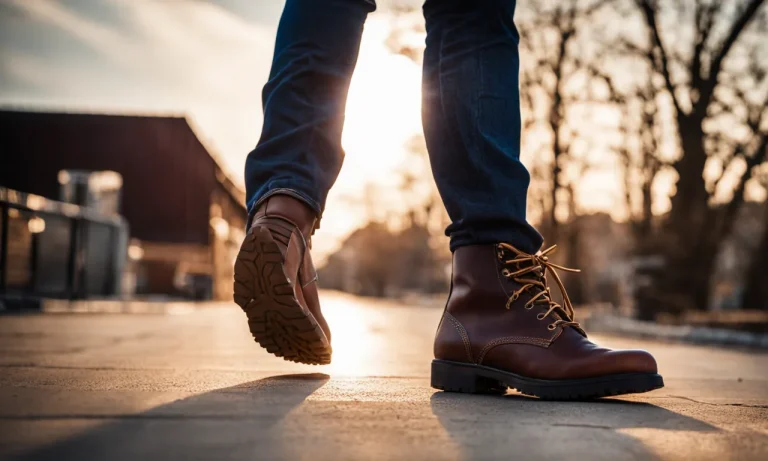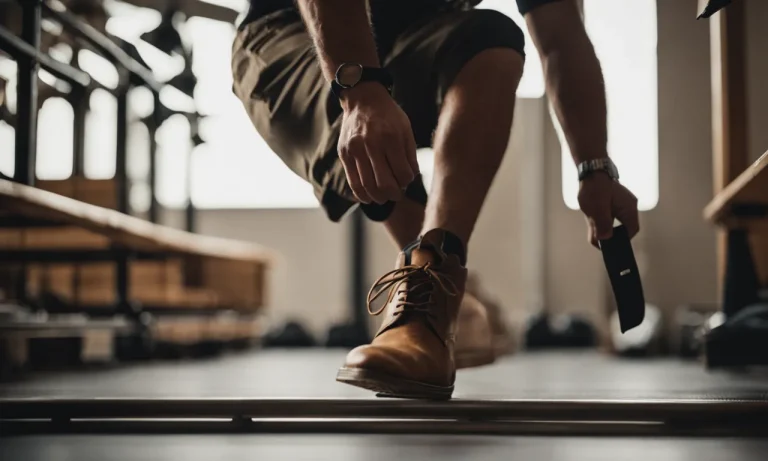With winter weather approaching, you may be wondering if your trusty Hunter boots can withstand the snow and ice. Hunters are popular rain boots, but how do they hold up in freezing temperatures and heavy snowfall?
In this comprehensive guide, we’ll cover everything you need to know about wearing your Hunter boots in cold and wintry conditions.
If you’re short on time, here’s a quick answer: Hunter boots can be suitable for light snow, but may not provide enough insulation and traction for heavy snowfall and icy conditions. Their waterproof rubber material keeps feet dry, but they lack built-in insulation and lug soles that perform best in snow and ice.
Hunter Boots Have Benefits for Light Snow
When it comes to tackling light snow, Hunter boots are a reliable choice. These iconic rubber boots have gained popularity for their durability and stylish design. While they may not be specifically designed for heavy snowfall or extreme winter conditions, they do offer several benefits for navigating through light snow.
Keep feet dry in wet snow
One of the main advantages of Hunter boots in light snow is their ability to keep your feet dry. Made from high-quality rubber, these boots are completely waterproof, ensuring that no moisture seeps through.
Whether you’re walking through slush or wet snow, you can trust that your feet will stay dry and comfortable.
Provide moderate warmth
Hunter boots offer a moderate level of warmth in light snow. While they don’t have built-in insulation like some winter boots, they still provide a layer of protection against the cold. The rubber material acts as a barrier, preventing heat loss and keeping your feet relatively warm.
However, if you’re planning to spend extended periods of time in extremely cold temperatures, it’s recommended to wear additional thermal socks for extra warmth.
Pair with thick socks for extra insulation
To enhance the warmth and insulation of Hunter boots in light snow, you can pair them with thick socks. This combination will provide additional warmth and keep your feet cozy even in chilly conditions. Wool socks, for example, are a great choice as they offer excellent insulation properties.
By layering up with the right socks, you can maximize the comfort and warmth provided by your Hunter boots.
It’s important to note that while Hunter boots are suitable for light snow, they may not be the best option for heavy snowfall or icy conditions. In such cases, boots with more advanced insulation and traction features would be more appropriate.
However, for everyday winter wear and light snow activities, Hunter boots can be a stylish and practical choice.
Potential Drawbacks of Hunter Boots in Heavy Snow
Not designed for extreme cold
While Hunter boots are known for their durability and waterproof capabilities, they are not specifically designed for extreme cold weather conditions. If you live in an area with frigid temperatures and heavy snowfall, you may find that these boots do not provide sufficient insulation to keep your feet warm.
According to REI, it’s important to choose boots that are rated for the expected temperatures you will be facing. Insulated boots with a temperature rating of -20 degrees Fahrenheit or lower are recommended for extreme cold.
So, if you’re planning to trek through the snow during a blizzard or spend extended periods of time outdoors in freezing temperatures, it might be wise to consider alternative options that offer better insulation.
Lack insulation for prolonged wear
One of the potential drawbacks of Hunter boots in heavy snow is their lack of insulation for prolonged wear. While they may keep your feet dry during short walks or errands in the snow, they may not provide enough warmth for longer periods of time spent outdoors.
If you’re planning to engage in activities such as snowshoeing, skiing, or snowboarding, where you’ll be constantly exposed to the elements, it’s recommended to invest in boots specifically designed for these activities.
Insulated snow boots, such as those with Thinsulate or other specialized insulation materials, can help keep your feet warm and comfortable even during extended periods of outdoor activity in the snow.
Smooth soles slip on ice
Another potential drawback of Hunter boots in heavy snow is their smooth soles, which can be slippery on icy surfaces. While the boots may provide excellent traction on wet and slushy terrain, they may not be as effective in providing grip on icy surfaces.
According to Healthline, boots with specialized treads or outsoles designed for icy conditions can help prevent slips and falls.
If you live in an area prone to icy conditions, it’s advisable to consider boots with anti-slip features or add-on traction devices like crampons or ice cleats to enhance grip and reduce the risk of accidents.
Tips for Wearing Hunter Boots in Snow
Spray boots with waterproofing treatment
While Hunter boots are known for their durability and water resistance, it’s always a good idea to give them an extra layer of protection before venturing out into the snow. One of the best ways to do this is by spraying your boots with a waterproofing treatment.
This will help to repel water and keep your feet dry even in wet and snowy conditions. There are many waterproofing sprays available on the market, so be sure to choose one that is suitable for the material of your Hunter boots.
Wear thick wool socks
When it comes to keeping your feet warm in the snow, the type of socks you wear is crucial. Opt for thick wool socks that provide insulation and moisture-wicking properties. Wool is a natural fiber that helps to regulate temperature and keep your feet dry by absorbing moisture.
By wearing thick wool socks, you’ll not only keep your feet warm but also reduce the risk of blisters and discomfort caused by wet feet.
Attach traction devices like Yaktrax
While Hunter boots are great for rainy conditions, they may not provide enough traction on icy or slippery surfaces. To enhance the grip of your boots and prevent slips and falls, consider attaching traction devices such as Yaktrax.
These devices are designed to fit over the soles of your boots and have metal coils or cleats that provide extra grip on icy terrain. They are easy to put on and take off, making them a convenient option for snowy conditions.
Bring extra socks to change into
Even with the best waterproofing treatment and wool socks, your feet may still get damp or sweaty during prolonged periods in the snow. To keep your feet comfortable and prevent any potential discomfort, it’s a good idea to bring along an extra pair of socks to change into.
This will allow you to swap out any damp or sweaty socks for dry ones, ensuring that your feet stay warm and cozy throughout your snowy adventures.
The Best Boots for Heavy Snow and Ice
When it comes to navigating through heavy snow and icy conditions, having the right pair of boots is essential. Here are some of the best types of boots that are designed to keep your feet warm, dry, and stable in winter weather:
Insulated winter boots
Insulated winter boots are specifically designed to provide warmth and comfort in cold temperatures. These boots are typically made with materials such as Thinsulate or wool lining, which help to trap heat and keep your feet cozy.
They also often feature waterproof exteriors to keep your feet dry in snowy conditions. Popular brands like Sorel and Columbia offer a wide range of insulated winter boots that are both stylish and functional.
Boots with lug soles
Boots with lug soles are known for their excellent traction on slippery surfaces. The lugs, or deep grooves, on the sole of these boots provide added grip and stability on ice and snow. This type of sole is commonly found on hiking boots and work boots, making them a great option for those who need to traverse through rugged terrain.
Brands like Timberland and Merrell offer a variety of boots with lug soles that are perfect for snowy conditions.
Waterproof leather/suede boots
Waterproof leather or suede boots are not only stylish but also highly practical for snowy weather. These boots are treated with special coatings that prevent water from seeping in, keeping your feet dry even in wet conditions.
Additionally, leather and suede are naturally insulating materials, providing warmth in cold temperatures. Popular brands like UGG and Blundstone offer a wide selection of waterproof leather and suede boots that are both fashionable and functional.
Boots rated for extreme cold
For those who live in regions with extremely cold temperatures, boots that are specifically rated for extreme cold are a must-have. These boots are designed with extra insulation and features such as removable felt liners or built-in thermal technology to keep your feet warm in subzero temperatures.
Brands like Baffin and Kamik specialize in producing boots that are built to withstand the harshest winter conditions.
Remember, when shopping for boots for heavy snow and ice, it’s important to consider factors such as insulation, traction, and waterproofing. Be sure to try on the boots and test their grip before making a purchase.
With the right pair of boots, you’ll be able to confidently tackle any winter weather that comes your way!
Hunter Insulated and Winter Boot Options
Hunter Original Refined Short Snow Boot
The Hunter Original Refined Short Snow Boot is a popular choice for those looking for a stylish and functional boot to wear in the snow. Made from durable rubber, these boots are designed to keep your feet dry and protected from the elements.
They feature a waterproof exterior, a non-slip sole, and a comfortable fit that allows for easy movement even in snowy conditions.
One of the key features of the Hunter Original Refined Short Snow Boot is its insulation. These boots are lined with a warm and cozy material that helps to keep your feet warm in cold temperatures. This insulation is designed to trap heat and prevent it from escaping, ensuring that your feet stay comfortable and toasty even in the coldest of conditions.
Hunter Original Insulated Chelsea Boot
The Hunter Original Insulated Chelsea Boot is another great option for those looking for a snow boot that combines style and functionality. These boots feature a classic Chelsea boot design with a waterproof exterior and a non-slip sole.
They are made from durable materials that are built to withstand the rigors of snow and ice.
One of the standout features of the Hunter Original Insulated Chelsea Boot is its insulation. These boots are lined with a thick and warm material that provides excellent insulation against the cold. This insulation helps to keep your feet warm and cozy, even in freezing temperatures.
Additionally, the boots have a cushioned insole for added comfort.
Hunter Slim Fit Insulated Boot
The Hunter Slim Fit Insulated Boot is a sleek and stylish option for those who want a snow boot that offers both warmth and style. These boots feature a slim fit design that hugs the leg, providing a sleek and modern look.
They are made from high-quality materials that are designed to be waterproof and durable.
One of the standout features of the Hunter Slim Fit Insulated Boot is its insulation. These boots are lined with a plush and warm material that provides excellent insulation against the cold. This insulation helps to keep your feet warm and comfortable, even in the harshest winter conditions.
Additionally, the boots have a cushioned footbed for added comfort.
When it comes to choosing a snow boot, Hunter offers a range of insulated and winter boot options that are designed to keep your feet warm and protected in the snow. Whether you prefer a short boot, a Chelsea boot, or a slim fit boot, Hunter has a style that suits your needs.
So, don’t let the snow stop you from enjoying the outdoors – invest in a pair of Hunter boots and tackle the winter weather with style and confidence!
Conclusion
In summary, original Hunter boots can be OK for occasional light snow, but aren’t ideal for frequent heavy snowfall and icy conditions. Make sure to waterproof them and pair them with thick socks for extra warmth and traction devices when needed.
For more frequent snow wear, look into insulated and lug-soled winter boot options, including some insulated Hunter styles. With the right precautions and proper winter boots, you’ll be prepared to take on whatever winter weather comes your way.






